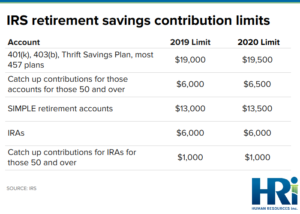News
The HR Strategist: BONUS ISSUE – December 2019
In this Issue:
- Update: 2020 Form W-4
- Requesting Updated W-2s and 1099s can Cost You Money
- Retirement Numbers for 2020
- Stay Connected!
Update: 2020 Form W-4
Just when you got used to completing the old W-4 form, updates have been made for 2020. December 5th marked the ‘unveiling’ of the final version of the new form, which is now titled as “Employee’s Withholding Certificate”. The major revisions are designed to make accurate income-tax withholding easier for employees beginning next year, and to provide simplicity, accuracy and privacy; while minimizing burden for employers and payroll processors.
Key Points Employers should Note:
- All new employees hired as of Jan. 1, 2020, must complete the new form.
- Current employees are not required to complete a new form but can choose to adjust their withholding based on the new form.
- Any adjustments made after Jan. 1, 2020, must be made using the new form.
- Employers can still compute withholding based on information from employees most recently submitted Form W-4 if employees choose not to adjust their withholding using the revised form.
- A new Publication 15-T, Federal Income Tax Withholding Methods, to be released in mid-December for use with the new 2020 Form W-4, will include steps employers can take to determine federal withholding.
So, what exactly changed? According to the Society for Human Resource Management (SHRM), the 2020 W-4 form includes a process with 5 possible steps for declaring additional income, so employees can adjust their withholding with varying levels of accuracy, privacy and ease.
The 5 Steps include:
- Enter personal information.
- Indicate multiple jobs or if spouse works
- Claim dependents.
- Make other adjustments (for income not from jobs, deductions claimed and extra withholding per pay period.
- Sign the form.
Although there are 5 steps, the IRS explains the only 2 steps required for employees are Step 1, where they enter personal information such as their name and filing status, and Step 5, where they sign the form. However, if Steps 2, 3 or 4 apply, and an employee chooses to complete and provide that information, their withholding will match their tax liability more accurately. Employees can also adjust their withholding in Step 4(c) without sharing additional information.
Privacy Concerns
The new form gives taxpayers a box to check to indicate they want more tax withheld without having to share details with their employer. However, this “new way” may lead to too much tax being withheld but will assist with those who prefer to receive a refund check, rather than owing at the end of the year. The IRS takes your privacy seriously and suggests that, if you are anxious about reporting income from multiple jobs in Step 2 or other income in Step 4(a), you check the box in Step 2(c) or enter an additional withholding amount in Step 4(c). To determine the additional withholding amount, you can use the withholding estimator.
withheld but will assist with those who prefer to receive a refund check, rather than owing at the end of the year. The IRS takes your privacy seriously and suggests that, if you are anxious about reporting income from multiple jobs in Step 2 or other income in Step 4(a), you check the box in Step 2(c) or enter an additional withholding amount in Step 4(c). To determine the additional withholding amount, you can use the withholding estimator.
HRi encourages our clients and supporters to perform a “paycheck checkup” to see if you need to adjust your current withholding in 2020. To conduct the checkup, you can use the IRS’s Tax Withholding Estimator (www.irs.gov/W4App). To effectively use the estimator, it is helpful to have a copy of your most recent pay stub and tax return. It is likely that the estimator will update to account for the 2020 tax tables in early January. Please note: if you do not submit a new form, withholding will continue based on your previously submitted form.
View the new W-4 Form Here!
The IRS has also published Frequently Asked Questions that you may find helpful as you complete the form (https://www.irs.gov/newsroom/faqs-on-the-draft-2020-form-w-4).
Requesting Updated W-2s and 1099s can Cost You Money
Don’t pay for last minute changes because of these:
Name
Address
Social Security Number
Be sure to update all personal and pay information for employees and contractors, before your W-2s or 1099s process! For HRi clients, we encourage you to log into your Employee Portal to ensure your information such as Name, Address, Social Security Number, E-mail, etc. is up-to-date! By doing so, our system automatically updates with the correct information; providing you with accurate documents.
Retirement Numbers You need to know for 2020
In 2020, you will be able to save as much as $19,500 in your 401(k) plan and up to $6,000 in your individual retirement account.
Savers who are age 50 and over will be eligible to put away up to $6,500 more in their 401(k) plans or another $1,000 in their IRAs.
Some key points include:
- New retirement savings plan limits mean that individuals under age 50 will be able to put away up to $19,500 in a 401(k) plan and up to $6,000 in an individual retirement account in 2020.
- If you’re on Social Security, your monthly checks will be 1.6% bigger starting in January, thanks to a cost-of-living adjustment.
- But Medicare premiums could be more expensive based on your income.
Below, we have provided a chart that compares the limits from 2019 to 2020:





